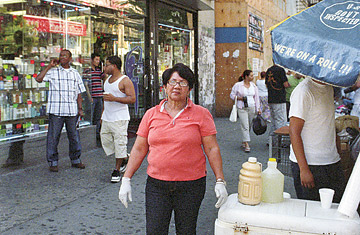
A loan from Grameen America allows Altagracia Familia to buy ingredients for the empanadas and sweets she sells from her cart.
(2 of 2)
Imported talent helped Grameen rival Acción, a big player in Latin American microfinance, establish a presence in the U.S. in the early 1990s. And yet even after years of making loans to small and upstart businesses, Acción still isn't profitable — an example of the challenge Grameen faces if it thinks it won't have to depend on donations for funding.
The working microfinance equation consists of borrowing funds cheaply and keeping loan defaults and overhead expenses sufficiently low. Microlenders overseas, including Grameen, do that by charging hefty interest rates — as high as 60% or 70%. (Yes, that's a colossal rate but one that's necessary to compensate for the risk and to attract bank funding.) But in the U.S., loans at rates much above Grameen America's standard 15% would most likely be attacked as usurious.
In the U.S., Acción has probably gotten closer to self-sufficiency than any other microlender by using technology and partnerships to boost efficiency. Acción Texas now underwrites loans for 12 different microfinance organizations, a pooling of talent designed to help all the groups more quickly remove their dependence on grants and community-reinvestment money.
Grameen's approach is different, since unlike most U.S. microfinanciers, it uses the group-lending model. Costs are kept down by having borrowers vet one another, tying together their financial fates and eliminating expensive loan officers entirely. Whether that setup will eventually allow Grameen to stand on its own two legs is a huge question mark.
And even if it can, it is still important to keep in mind exactly what a $1,500 loan can do. The ultimate promise of Grameen — and of microfinance more broadly — is to use business lending as a way for people to lift themselves out of poverty.
Grameen America provides a fascinating lens through which to view that ideal. More often than not, the borrowers Grameen finds in the U.S. already have jobs (as factory workers or home health aides, for example) as well as side businesses — selling toys or Amway products, cleaning houses or giving haircuts. The loans from Grameen, by and large, provide a steadier source of funding, but they don't create businesses out of nothing.
Take, for instance, Altagracia Familia, a former schoolteacher in the Dominican Republic who now lives in New York City and sells empanadas and coconut sweets. Her vending cart used to be wooden, but then she upgraded to metal. Not by way of a loan, though. Familia slowly saved profits and bought a new cart once she had amassed $7,000. What she spent her Grameen loan on is much less flashy: ingredients and cart repairs.
That's not to say the money isn't helpful. But according to Familia, one of the main things she gets from Grameen is something else: "their interest is in developing women workers," she says through a translator. "Women share their ideas and help each other out."
That correlates with what Jeffrey Ashe found in the 1990s when he ran a group-lending outfit. Working Capital, which had branches from Burlington, Vt., to Miami, eventually collapsed, but at its height the entrepreneurs were tremendous sources of support to one another, says Ashe. "I'd say that might have been more important than the loans," he recalls. "After they stopped borrowing, a lot of the groups would still meet — to help with bookkeeping, to refer customers to each other." Even if microlending isn't a clear-cut pathway out of poverty — and years of studies have yet to settle that debate — it could still be doing something very useful.
Back at Ziomara Suarez's apartment, the formal loan collection ends, but the women of the Progressives — what the group has named itself — stick around. As Emily Medina leaves to deposit the cash she's collected, the borrowers continue to chat and laugh and swap stories about the ups and downs of business. Then one of them opens up a suitcase and starts selling jeans and T-shirts out of it.
— With reporting by Natasha del Toro
